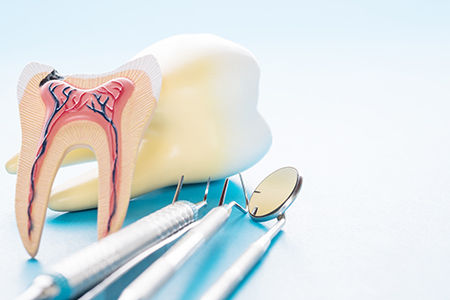
If a dentist tells you a tooth needs a root canal, try not to panic. Modern root canal therapy is a familiar, highly refined dental procedure that focuses on relieving pain, removing infection, and preserving the natural tooth whenever possible. With today's techniques and anesthesia, the treatment is generally well tolerated and aimed at restoring both comfort and function.
At Callahan Family Dentistry, we combine up-to-date technology with a patient-centered approach to make the experience as smooth and predictable as possible. Comfort, clear explanations, and careful attention to healing are central to how we deliver care.
Root canal therapy is intended to save a tooth that would otherwise need extraction because the soft tissues inside the tooth (the pulp) are infected or irreparably damaged. By removing the inflamed or infected pulp and sealing the internal canals, the procedure preserves the tooth’s outer structure and lets you keep the tooth’s role in chewing and maintaining the jaw’s alignment.
Success rates for modern root canal procedures are high when the treatment is performed and followed up with appropriate restoration. Choosing to retain a natural tooth whenever feasible helps maintain facial structure, prevents neighboring teeth from shifting, and avoids many of the long-term effects that can follow tooth loss.
Every tooth and situation differs, so whether root canal therapy is the best option depends on the amount of remaining tooth structure and the overall health of the surrounding bone. Your dentist will evaluate these factors and explain the benefits and limitations of treatment in clear, practical terms.

Teeth are composed of more than enamel and dentin; a central pulp chamber contains nerves, blood vessels, and connective tissue that support the tooth’s development and sensitivity. When that pulp becomes injured, infected, or necrotic, it can trigger a range of symptoms that warrant evaluation and, often, treatment.
Not every ache requires root canal therapy, but certain signs are common indicators that the inner tissues are compromised. Sensations that change in severity, new or unexplained pain, or visible changes to a tooth usually call for prompt assessment. Early diagnosis can simplify treatment and improve healing outcomes.
Ongoing pain—especially pain that disturbs sleep or intensifies over time—is a red flag. While many conditions can cause dental discomfort, persistent tooth pain often signals that the pulp has been affected and should be examined without delay.
If hot or cold foods and drinks produce a sharp, lingering ache rather than a brief twinge, the pulp may be inflamed. This sensitivity can be an early clue that deeper treatment is needed to prevent more serious complications.
Discomfort that appears with pressure—when chewing or simply touching the tooth—can suggest that the nerve is irritated or that an infection is affecting surrounding tissues.
A tooth that becomes darker or discolored over time may have suffered internal damage. Color changes can reflect loss of vitality in the pulp and should prompt an evaluation.
An injury that fractures or chips a tooth can expose or traumatize the pulp. Even when a crack seems minor, it can create pathways for bacteria to reach the inner tissues, sometimes necessitating root canal therapy.
Swelling of the gums, the presence of a pimple-like bump on the gum, or any draining around a tooth often indicates an underlying infection. These signs require prompt attention to prevent spread and to protect overall oral health.
When an infection or bone loss affects the tissues that support a tooth, the tooth may feel loose or shift slightly. Addressing the source of infection with appropriate therapy can often resolve these changes and help preserve the tooth.

Delaying care when a tooth’s pulp is compromised increases the likelihood that infection will spread to surrounding bone or adjacent teeth. Early treatment can limit damage, reduce the number of visits needed, and make restoration simpler and more predictable.
Some teeth that need root canal therapy do not cause obvious symptoms at first and may be discovered during routine exams or on x-rays. Radiographic signs such as changes around the tooth’s root tip can reveal hidden problems that deserve attention before more serious consequences occur.
Because infections in the mouth can affect more than just a single tooth, timely intervention protects oral health and supports overall well-being. Your dentist will explain the options and help you prioritize care based on the tooth’s condition and your health needs.
Root canal treatment typically begins with a careful examination, diagnostic x-rays, and a discussion about comfort measures. The area is numbed with local anesthesia to control pain, and many patients experience little more than pressure during the procedure.
The dentist will remove the diseased or dead pulp, shape and clean the internal canals, and then fill them with a biocompatible material to seal the space. Today’s instruments and materials improve cleanliness and sealing, which supports long-term success.
Some treatments are completed in a single appointment, while others—especially those that begin with infection—may require two or more visits to ensure thorough cleaning and healing. If anxiety or special comfort needs are a concern, dental sedation options are available and can be discussed beforehand.
After the internal work is complete, the tooth will usually receive a durable restoration, often a crown, to protect it from fracture and to restore normal function. Securing the tooth with an appropriate restoration is a key step in preserving its strength over time.

Immediately after treatment you may experience lingering numbness for a short time and some tenderness as tissues settle. Mild to moderate discomfort is common for a few days and is usually managed with over-the-counter pain relief and short-term home care measures recommended by your dentist.
If antibiotics are prescribed to manage or prevent spread of infection, it’s important to complete the full course exactly as directed. Likewise, follow-up visits are scheduled to confirm healing and to proceed with the permanent restoration that will protect the treated tooth.
Continue to clean your teeth carefully around the treated tooth and maintain regular dental checkups. With a well-fitted restoration and good oral hygiene, a tooth that has had root canal therapy can remain functional for many years — often a lifetime.
At the office of Callahan Family Dentistry, our team emphasizes clear instructions and close follow-up to support a smooth recovery. If you experience increasing pain, swelling, prolonged fever, or any worrisome symptoms after treatment, contact us promptly for evaluation.
In summary, root canal therapy is a proven, tooth-preserving treatment that relieves pain, removes infection, and restores function. If you have signs or symptoms described here or would like an evaluation to determine the best course of care, please contact us for more information.
A root canal procedure is the best way to save a tooth that has been damaged by decay or injury and preserve your natural smile. The alternative is an extraction and treatment to replace the tooth. While at times a tooth is non-restorable and an extraction is the only option, when possible, it’s best to try and save your natural tooth. With proper care, a tooth with root canal therapy can serve your smile well for many years to come.
Despite lingering myths from before the age of modern dental anesthesia and technology, having a root canal procedure today is as routine and comfortable as visiting the dentist for a filling. While the procedure is performed under local anesthesia with your tooth completely numbed, we can also discuss options in dental sedation.
Whether the symptoms of a dental infection subside after a course of antibiotics, a draining abscess provides you with some temporary pain relief, or a tooth with radiographic evidence of pathology has not yet developed symptoms, it’s essential, before an infection worsens or occurs, to have a root canal procedure performed. In this way, the tooth can be disinfected, filled, and sealed to protect your health and avoid further problems.
If you have sustained a dental injury, have a toothache, jaw pain, swelling, or are experiencing any other unusual and uncomfortable oral symptoms, contact our office immediately for care. Dental problems that have not been evaluated and treated can significantly worsen, producing more severe damage and consequences for the involved teeth, your oral health, and even your overall wellbeing. Once you get in touch with our office, our friendly and compassionate office team will get you in for care at your earliest convenience.
While some root canal procedures can be completed in one visit, others may involve 2 or 3 appointments. How long it takes depends on various factors, including active infection, the number of canals in the tooth, and the tooth’s location or anatomy.
With a success rate that exceeds 95%, root canal therapy remains the most effective procedure to save a tooth in which the inner vital tissues have been damaged. However, as with all healthcare procedures, there are a small percentage of cases where the teeth become symptomatic a second time. The good news is that many of these teeth can still be saved with root canal retreatment or a minor surgical procedure known as an apicoectomy.
The best ways to maintain a tooth with root canal therapy are to get the proper restoration required to rebuild and protect the tooth, maintain proper oral hygiene, and schedule appointments for routine dental checkups and care.
Saving a tooth with root canal therapy is a wise investment that, in the long run, is typically less costly and invasive than having the tooth extracted and replaced with a fixed bridge or implant. As far as the exact cost of care, it can vary depending on which tooth is being treated. Many dental insurance plans provide coverage for root canal therapy. At the office of Callahan Family Dentistry, we do our best to optimize your dental benefits and minimize your out-of-pocket expenses. Our staff will answer all your questions about the cost of care and discuss all your payment options.
At the office of Callahan Family Dentistry, we use the latest technology and most effective methods of care to provide precise and gentle care. Our reputation for excellence is based upon a consistent record of achieving successful treatment outcomes while providing prompt, stress-free, and convenient treatment for every type of dental need.
Our goal is to help every patient experience the benefits of good oral health and a beautiful smile. We value the trust you have placed in our office and strive to provide solutions that meet your dental needs and expectations of care.
